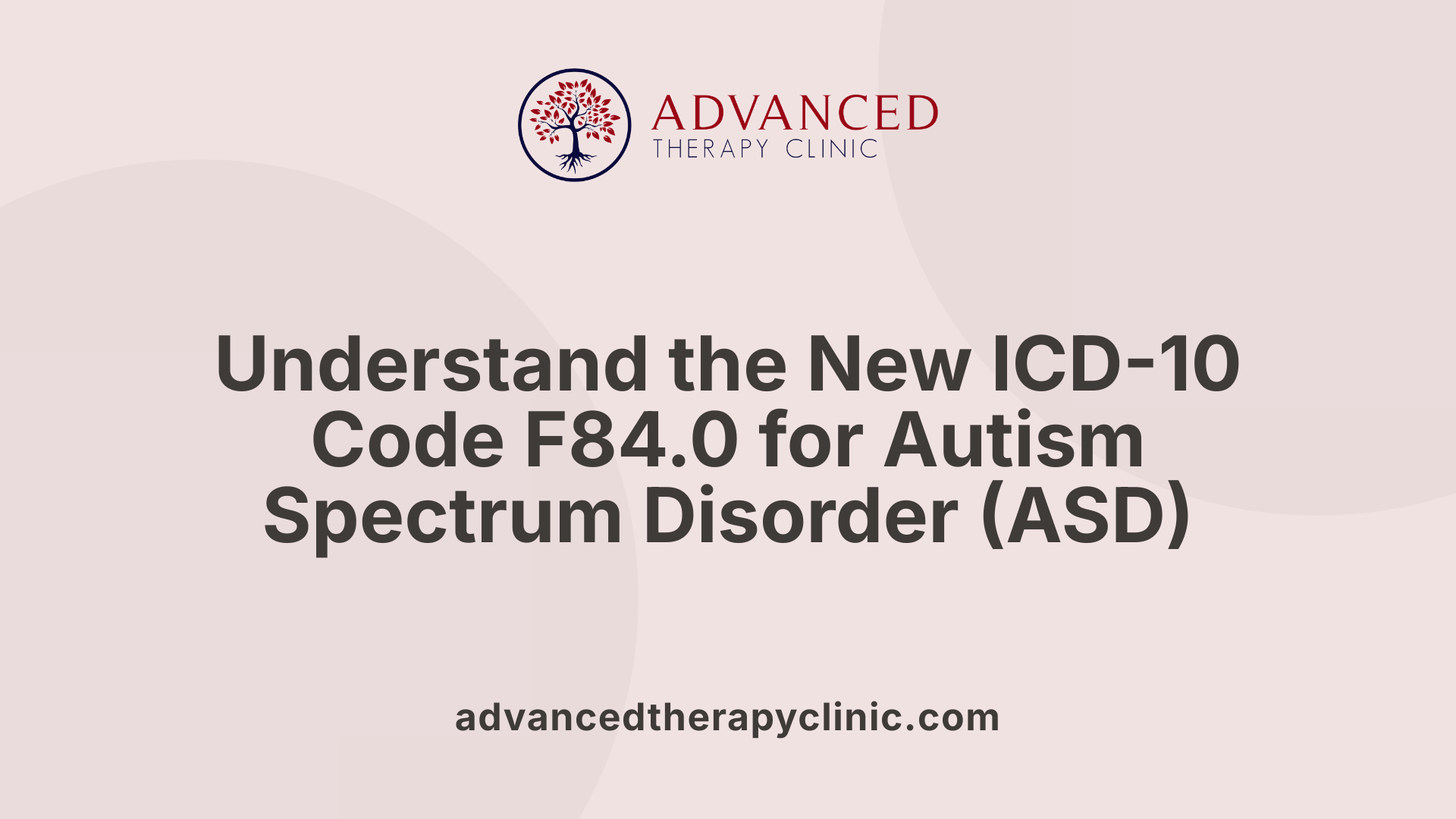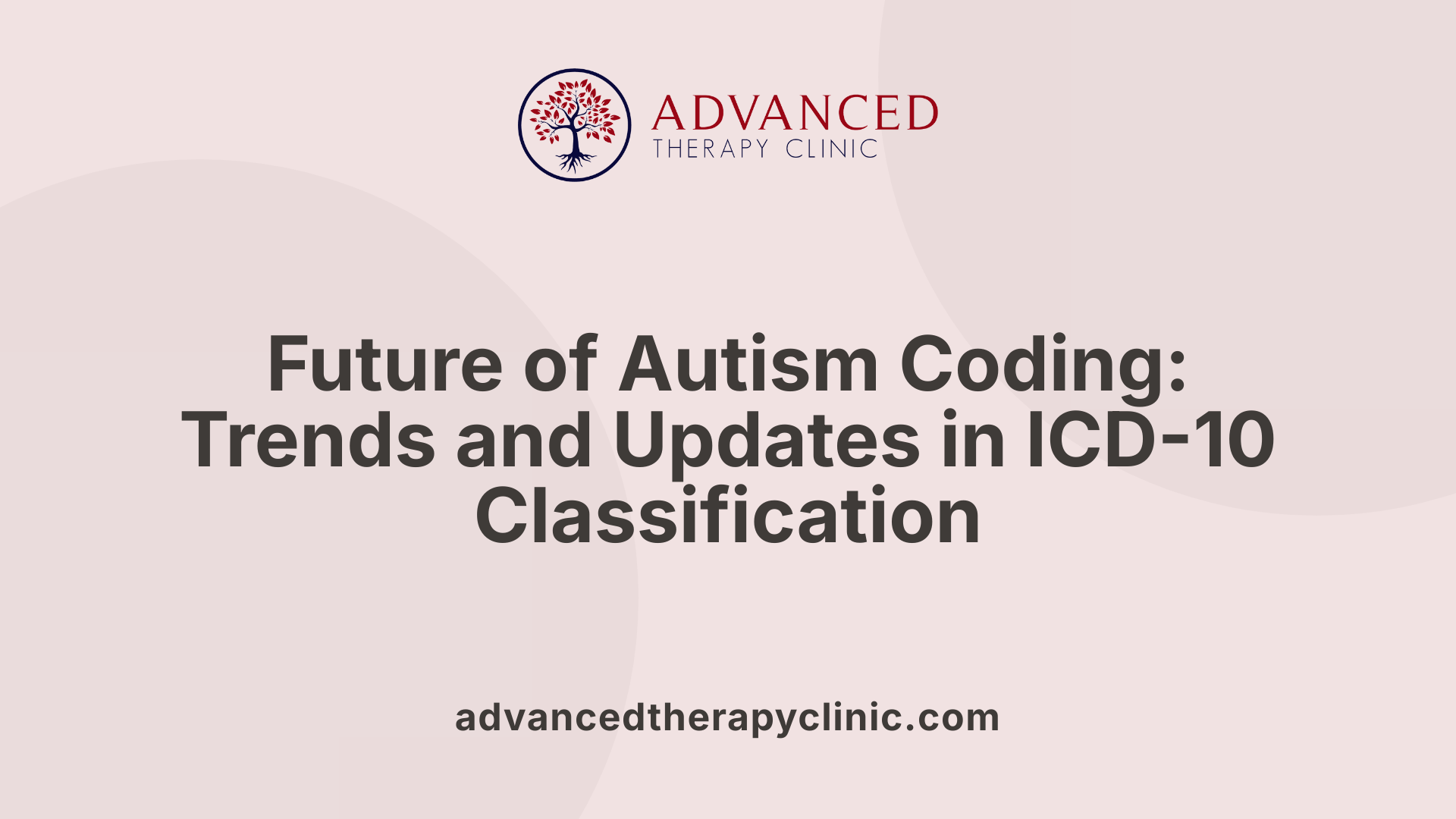ICD-10 Code For Autism


Introduction to Autism and Its Coding
The International Classification of Diseases, Tenth Revision, Clinical Modification (ICD-10-CM), provides a standardized system for diagnosing and coding autism spectrum disorder (ASD). Accurate classification is essential for clinical diagnosis, treatment planning, billing, and research. This article offers a comprehensive overview of the ICD-10 code F84.0, which specifically addresses autism, along with guidelines for usage, documentation, and verification.
The Specific ICD-10 Code for Autism Spectrum Disorder (ASD)

Code F84.0 details and classification
The ICD-10-CM code F84.0 is the official diagnosis code used internationally to identify autism spectrum disorder, particularly autistic disorder, infantile autism, or Kanner’s syndrome. Debuted in the 2025 ICD-10 edition, effective from October 1, 2024, this code is essential for healthcare providers, insurance billing, and medical documentation. It is a specific, billable code that helps ensure accurate coding and reimbursement processes across countries.
Autism is classified under the ICD-10 system within the category of pervasive developmental disorders, which include conditions characterized by impaired communication and social interaction, along with repetitive behaviors. The fully detailed descriptor for F84.0 encompasses several conditions, mainly childhood autism and Kanner’s syndrome. Proper use of this code requires a formal diagnosis by qualified healthcare professionals, supported by evidence of persistent deficits in social communication and restricted, repetitive patterns of behavior.
Its classification under F84 signifies its placement among mental, behavioral, and neurodevelopmental disorders, emphasizing its lifelong nature and the importance of early diagnosis. Although treatment can improve functioning, autism currently has no cure, making early detection vital.
Scope of F84.0 including related conditions
The scope of F84.0 involves not only typical autism but also related diagnoses like infantile psychosis and infantile autism. The code also covers cases previously diagnosed under similar terms, streamlining diagnosis, treatment, and billing.
It is important to distinguish F84.0 from other spectrum conditions. For example, F84.5 is used exclusively for Asperger’s syndrome, which is considered mutually exclusive of F84.0 according to ICD-10 guidelines. Additionally, clinicians may code for other related social and communication disorders using codes like F80.82 for social pragmatic communication disorder or F80.2 for mixed receptive-expressive language disorder when autism is suspected but not yet confirmed.
In some cases, multiple codes are used to fully capture a patient’s diagnostic profile. Alongside F84.0, codes like R48.8 (other symbolic dysfunction) may describe associated cognitive or social communication difficulties.
Effective date of the code and its international use
The ICD-10 code F84.0 became effective on October 1, 2024, as part of the ICD-10-CM updates for 2025. This international standard is used across many countries to maintain consistency in diagnosis, billing, and research. It aligns with guidelines from the World Health Organization (WHO), ensuring uniformity in classification.
The use of F84.0 is crucial for documentation, tracking epidemiological data, and facilitating healthcare planning. Accurate coding supports better patient management and improved access to services, especially with recent updates like the introduction of new screening codes such as Z13.41.
| Aspect | Details | Additional Notes |
|---|---|---|
| ICD-10 Code | F84.0 | Used for diagnosed autism spectrum disorder (ASD) |
| Effective Date | October 1, 2024 | Implemented in the ICD-10-CM 2025 edition |
| Classification | Pervasive developmental disorders | Under the WHO section - Mental, Behavioral, Neurodevelopmental |
| Related Conditions | Infantile autism, infantile psychosis, Kanner’s syndrome | Excludes Asperger’s syndrome (F84.5) |
| Additional Codes for ASD symptoms | F80 series (speech and language disorders) | For developmental speech, language, or social issues |
| International Use | Yes, globally recognized | Used for diagnosis, billing, and epidemiology |
Understanding the specific coding for autism spectrum disorder ensures better clinical documentation, supports appropriate billing practices, and helps in the global effort to understand and address autism more effectively.
Coding Guidelines and Effective Date for Autism Diagnosis

What are the guidelines for coding autism in clinical and billing contexts?
Properly coding autism spectrum disorder (ASD) requires precise documentation by healthcare providers. The ICD-10-CM code F84.0 is designated for autistic disorder, also known as childhood autism, infantile autism, or Kanner’s syndrome. Clinicians should record detailed clinical findings, including behavioral assessments, developmental history, and the fulfillment of diagnostic criteria such as persistent deficits in social communication and restricted, repetitive behaviors.
In billing contexts, it is essential to follow payer-specific rules for code sequencing. Usually, at least two codes are reported: one for the autism diagnosis (F84.0) and additional codes for associated conditions or communication disorders, such as F80.2 (mixed receptive-expressive language disorder) or R48.8 (other symbolic dysfunction).
When ASD is suspected but not yet confirmed, preliminary diagnostic codes like F80.2 can be used as placeholders during assessments. Screening encounters should utilize codes like Z13.41, which indicates autism screening. Accurate and detailed coding not only supports appropriate reimbursement but also ensures clear clinical documentation for ongoing care and multidisciplinary communication.
When did the ICD-10 code F84.0 become effective, and what is its international relevance?
The ICD-10 code F84.0 became effective on October 1, 2024, as part of the updates incorporated into the 2025 ICD-10-CM edition. This latest implementation aligns with global standards for health diagnosis coding.
The ICD-10 classification system is used internationally, maintained by the World Health Organization (WHO). Its adoption ensures that healthcare providers, researchers, and insurers across countries maintain consistency in diagnosing and billing for autism spectrum disorder. By standardizing the coding process, F84.0 facilitates accurate tracking of autism prevalence, supports epidemiological research, and streamlines cross-border healthcare documentation.
This international recognition underscores the importance of current and uniform coding practices, enabling healthcare professionals worldwide to communicate diagnoses effectively and ensure that individuals receive appropriate services based on reliable clinical data.
| Aspect | Details | Additional Notes |
|---|---|---|
| Effective Date | October 1, 2024 | Implemented in ICD-10-CM 2025 edition |
| International Status | Recognized globally | Used by WHO and health authorities worldwide |
| Purpose | Diagnosis documentation, billing, research | Ensures consistency in clinical practice and data collection |
| Related Codes | F80 series, R48 series, Z13.41 for screening | Combo codes for comprehensive documentation |
| Usage | Medical diagnosis, billing, clinical record keeping | Must follow payer-specific guidelines |
By adhering to these coding standards, healthcare providers can ensure diagnostic accuracy, proper reimbursement, and meaningful data collection worldwide.
Understanding Diagnostic Categories and Related Codes

What are the diagnostic categories and coding standards related to autism spectrum disorder?
Autism spectrum disorder (ASD) is primarily identified in the ICD-10-CM system with the code F84.0. This specific classification, known as childhood autism or infantile autism, covers a range of conditions including autism spectrum disorder, Kanner’s syndrome, and infantile psychosis. It is part of the broader ICD-10 category for pervasive developmental disorders.
The code F84.0 is used by healthcare providers to document and bill for autism-related services, and effective from October 1, 2024, it has become a billable code. When diagnosing, clinicians must confirm evidence of persistent deficits in social communication and interaction, along with restrictive, repetitive behaviors.
In addition to F84.0, other relevant codes include F84.1, which is designated for atypical autism. This term describes cases where the age of onset or clinical presentation does not fully align with F84.0 criteria. Another important code is F84.5, used specifically for Asperger’s syndrome, which is considered separate from classic autism within the ICD-10 classification.
Supplementary codes such as R48.8 are often used to specify associated language, cognitive, and social communication disorders. These complementary codes help provide a comprehensive picture of the individual's developmental profile and guide targeted interventions.
Proper coding often involves using F84.0 as the main diagnosis, supplemented by additional codes depending on the patient's specific presentation and treatment needs. Clear documentation is essential for accurate billing, diagnosis, and tailored therapeutic strategies.
How does the ICD-10 system differentiate between various autism-related conditions?
The ICD-10 system assigns distinct codes to delineate the different conditions within the autism spectrum. For instance, F84.0 is reserved for childhood autism, which typically manifests early in life with prominent social and communication challenges. In contrast, F84.5 covers Asperger’s syndrome, characterized by average or above-average intelligence and fewer language difficulties.
F84.1, or atypical autism, is used when a patient exhibits some symptoms of autism but does not meet all criteria for F84.0—often owing to later age of onset or atypical symptom patterns. This clear differentiation enables clinicians to accurately document the spectrum's diversity, which supports tailored treatment plans and appropriate billing procedures.
The classification ensures that each condition receives the recognition needed for research, resource allocation, and clinical management. It also facilitates communication among healthcare providers, payers, and researchers, establishing a common language for describing developmental disorders.
Additional Details and Coding Considerations
| Code | Condition | Description | Diagnostic Notes |
|---|---|---|---|
| F84.0 | Childhood Autism | Classic autism with early onset and pervasive symptoms | Often diagnosed before age 4, includes Kanner's syndrome |
| F84.1 | Atypical Autism | Autism that does not meet full criteria for F84.0 | May have later onset or fewer symptoms |
| F84.5 | Asperger’s Syndrome | Autism with no significant language delay | Often associated with normal to high intelligence |
| F84.9 | Pervasive Developmental Disorder Unspecified | Conditions on the spectrum not classified elsewhere | Used when full clinical picture is unclear |
Additional codes like R48.8 (other symbolic dysfunction) are used alongside to specify related communication issues. Multiple codes might be necessary depending on payer requirements and the details of clinical presentation.
By understanding these distinctions and coding conventions, healthcare providers can ensure precise documentation, which enhances treatment planning and reimbursement processes.
Application of Coding in Clinical Practice and Billing
How can healthcare professionals verify and apply the correct ICD-10 code for autism?
Healthcare professionals verify the correct ICD-10 code by conducting comprehensive assessments that evaluate social communication, social interaction, and repetitive behaviors. These observations align with the diagnostic criteria for Autism Spectrum Disorder (ASD). When these criteria are met consistently, the primary diagnosis code F84.0 is assigned. Clinicians should document the specific signs supporting the diagnosis, such as language delays or behavioral patterns.
In addition to the core diagnosis, it is important to record any co-occurring conditions. For example, if a patient exhibits language impairments, an additional code from the F80 series, like F80.2 for mixed receptive-expressive language disorder, might be appropriate. Similarly, social communication issues might warrant code R48.8.
Staying updated with payer-specific coding sequences and rules is crucial. Some payers may require certain codes to be listed first, while others focus on the primary diagnosis to ensure proper reimbursement. Consulting the latest ICD-10-CM guidelines, using current coding manuals, and seeking expert opinion when needed help guarantee correct code application. Proper verification ultimately depends on clear documentation, detailed clinical findings, and adherence to coding standards.
What role does documentation play in ensuring effective coding for autism?
Accurate and thorough documentation is fundamental to correct coding and billing for autism. It provides the evidence needed to justify the diagnosis of F84.0. Clinicians should record detailed developmental histories, including age of onset, behavioral observations, standardized assessment results, and specific diagnostic criteria met. Documenting the severity of symptoms, level of support needed, and functional impairments strengthen the diagnosis.
Additionally, noting any associated conditions like intellectual disabilities or communication disorders supports the selection of additional codes, such as those from the R48.8 series. This level of detail ensures that the coding accurately reflects the patient's clinical picture.
Effective documentation also plays a role in reducing billing errors and claim denials. Payers rely heavily on detailed records to process claims, justify reimbursement, and ensure compliance with coding standards. In summary, comprehensive documentation not only supports accurate coding but also enhances clinical transparency and helps in securing appropriate billing outcomes.
Additional insights about coding practices and considerations
| Aspect | Details | Notes |
|---|---|---|
| Main diagnosis code | F84.0 (Autistic disorder, autism spectrum disorder) | Use for confirmed autism diagnosis |
| Related disorders | F84.5 (Asperger's syndrome), F84.1 (Atypical autism) | Exclude from F84.0 per coding guidelines |
| Co-occurring conditions | R48.8 (other symbolic dysfunction), F80 series (speech/language disorders) | Additional codes for associated issues |
| Coding sequence | Payer dependent; often primary is F84.0, with others following | Verify payer instructions |
| Billing considerations | Use of CPT codes (e.g., 92507, 92508) for therapy services; Z13.41 for screening encounters | Accurate documentation supports billing |
| Effective date of code | October 1, 2024, for the 2025 ICD-10 edition | Important for current coding practices |
This structured approach helps healthcare providers accurately document, code, and bill for autism spectrum disorder, ensuring compliance and optimal patient care outcomes.
Summary and Future Directions

What is the ICD-10 code for autism and how is it classified?
The ICD-10 code for autism is F84.0. This classification encompasses various forms of autism spectrum disorder, including childhood autism, infantile autism, and Kanner’s syndrome. Introduced to be effective from October 1, 2024, F84.0 is a specific, billable diagnosis code used internationally for medical documentation, billing, and clinical research purposes.
F84.0 is categorized under the broad range of pervasive developmental disorders within the ICD-10 system. Its main role is to ensure consistent diagnosis across different healthcare providers and settings. This classification aids in differentiating autism from other neurodevelopmental conditions, such as Asperger’s syndrome (F84.5), which the ICD considers mutually exclusive with F84.0. Accurate coding is essential for treatment planning, research, and reimbursement.
How should clinicians and coders verify and document ASD diagnoses?
Verification of an autism spectrum disorder diagnosis involves thorough clinical assessment by qualified healthcare professionals. Clinicians typically base their diagnosis on standardized criteria, such as those outlined in the DSM-5, combined with detailed developmental histories, behavioral observations, and assessment tools.
Once a diagnosis of F84.0 is confirmed, it should be accurately documented with comprehensive notes on social communication deficits, restrictive behaviors, and the developmental course. Supplementary codes from the ICD-10, such as those from the R48 series, may be used to describe associated language, social, or cognitive issues.
In terms of coding, clinicians and coders should stay updated on the latest guidelines, including the recent addition of screening codes like Z13.41 for autism screening encounters introduced for 2025. Proper documentation and adherence to payer-specific requirements are critical to ensure eligibility for reimbursement. Continuous education on coding standards and an understanding of the evolving ICD-10 landscape are vital for optimal clinical and billing practices.
Upcoming updates or changes
Future developments in autism diagnosis coding may include more detailed subcategories as understanding of the spectrum advances. Also, with the inclusion of new screening codes like Z13.41, early detection and intervention strategies are becoming more integrated into standard practice.
Ongoing research and updates from international health organizations may influence further refinement of ICD-10 codes, ensuring they reflect current diagnostic criteria and clinical practices. Clinicians and coders should regularly review guidelines and updates from authoritative sources like the WHO and CMS to maintain compliance and enhance patient care.
| Aspect | Current Status | Future Considerations | Remarks |
|---|---|---|---|
| ICD-10 Code | F84.0 | Possible granular subcategories | Reflects autism severity or subtype |
| Screening Codes | Z13.41 (added for 2025) | Expanded screening protocols | Promotes early detection |
| Diagnostic Criteria | DSM-5 aligned | Ongoing refinement | Based on latest clinical research |
| Documentation | Detailed behavioral assessment | Standardized reporting templates | Ensures accuracy and reimbursement |
In conclusion, the ICD-10 coding system for autism, represented by F84.0, is crucial for consistent recognition and management of autism spectrum disorder worldwide. Staying current with updates and best practices in diagnosis and coding will continue to improve outcomes for individuals across the spectrum.
Summary and Final Thoughts
Coding autism spectrum disorder accurately using ICD-10 codes is fundamental for quality clinical care, effective billing, and ongoing research. The primary code, F84.0, reflects the core diagnosis of childhood autism, with additional codes available to detail related conditions and communication disorders. Strict adherence to documentation standards and awareness of coding updates, such as the 2025 effective date for F84.0 and the new screening code Z13.41, ensure compliance with payer requirements and facilitate optimal patient management. As understanding of ASD continues to evolve, healthcare professionals must stay updated on coding standards to support diagnosis, treatment, and reimbursement efforts.
References
- 2025 ICD-10-CM Diagnosis Code F84.0: Autistic disorder
- ICD-10 Version:2019
- The Right Codes for ASD-Related Services
- ICD-10-CM Code for Autistic disorder F84.0
- ICD-10 Code F84.0 for Autistic Disorder: Complete 2025 ...
- What is the ICD Code for Autism?
- Pervasive developmental disorders F84
- The Right Codes for ASD-Related Services
- ICD-10 Version:2019
Recent articles

Expressive Speech Delay 2-Year-Old
Understanding and Addressing Expressive Speech Delay in Toddlers

How Speech Recognition Works
Unlocking the Power of Speech Recognition in Therapy and Healthcare

Autism and Head Size
Understanding the Complex Relationship Between Autism and Head Size

Occupational Therapy in Autism
Enhancing Independence and Quality of Life Through Occupational Therapy in Autism

Do Autistic People Understand Sarcasm?
Navigating the Nuances: Understanding Sarcasm and Social Communication in Autism

Autism Routines
Crafting Effective Daily Structures for Children with Autism

